|
|
|
|
|
|
|
Achi-Kochi Japan
Showing many places to visit and foods to eat in Japan
|
|
|
|
|
|
|
|
|
|
|
|
|
Japan
> Hokuriku region
> Wajima and Noto Hanto
|
|
|
|
|
|
|
Wajima City and Noto Hanto
Ishikawa Pref., Hokuriku ( Achi-Kochi Japan )
|
|
|
|
|
|
|
|
|
|
|
|
|
( "Achi-Kochi" in Japanese means "Here and there" in English. )
Earthquake
On the 1st January 2024, Wajima City and Noto Hanto ( Noto Peninsula ) were attacked by a major earthquake which killed a few hundred people, injured a few thousands and destroyed dozens of thousands of houses. Even now so many people are struggling to rebuild their lives. A rapid recovery is prayed.
|
Wajima City, Ishikawa Pref., Hokuriku Region

Noto Hanto ( Noto Peninsula ) is located in the north of Ishikawa Prefecture and in the north of Hokuriku Region. Wajima City is located in the northwest of the peninsula ( above ). There in Wajima City are accommodation facilities. So for tourists who would like to visit many places in the peninsula, it could be recommended to stay in hotels, ryokan or guesthouses in the city.
In addition, there in Wajima City are many sites to visit, things to see, various seafood dishes to eat, though Wajima is a small city whose population is a little more than 24 thousands.
|
|
Asaichi ( Morning Market )

Asaichi ( Morning Market - above ) is one of the most famous and popular attractions in Wajima City. Asaichi is held in the center of the city through 8:00 AM - noon everyday except the 2nd and 4th Wednesday every month. It is said that Asaichi has more than 1,000 years of history.
|
|
Marine Products and Vegetables
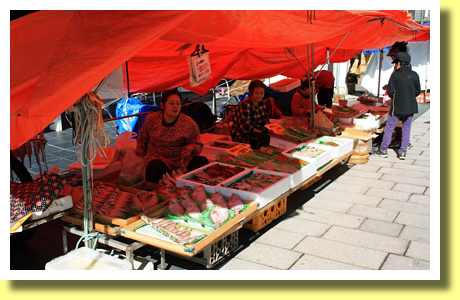
In Wajima Asaichi, there are more than 200 stalls ( above ) selling
various marine products ( fresh, salted and dried ) and vegetables. Most of the stalls are run by wives of fishermen and farmers.
|
|
BBQ Grills

In Wajima Asaichi, there is a hut ( above ) where BBQ grills are prepared for tourists for free. BBQ grills are ready through 8:30 AM - 11:30 AM. Paper plates and disposable chopsticks are prepared in the hut. Tourists could buy coffee and/or rice ball in the hut as well.
|
|
Charcoal Fired Dried Fish

1) Buy some dried fishes in Wajima Asaichi.
2) Find the BBQ hut and grill available in the market.
3) Grill the fishes ( such as dried willowy flounder - above ).
4) Enjoy BBQ grilled fishes.
Near Asaichi market there are some shops ( not stalls ) selling cans of beer and/or sake. However drinking-and-driving is strictly prohibited in Japan.
|
|
Wajima Kiriko Festival Museum

Achi-Kochi ( here and there ) in Noto Hanto ( peninsula ), various Kiriko Festivals have been and are held in august for a few hundreds years. In Wajima City, Kiriko Festival is held on 22nd - 25th every august and Wajima Kiriko Festival Museum displays lots of large and small Kiriko lanterns ( above ) which are used in the festival.
Some Kirikos are as heavy as 2 tons and as high as 15 meters. On the occasions of festivals, Kiriko lanterns are lit and carried around the towns by local people. Each area has their own way to enjoy the festival and their own Kiriko lanterns.
|
|
Wajima-nuri ( lacquerware )
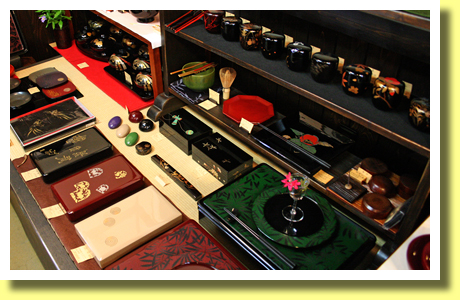
The city is famous for Wajima-nuri ( a kind of Japanese traditional lacquerware ). The technique of Wajima-nuri has been used to decorate Kiriko Lanterns. There are many shops where tourists could buy various Wajima-nuri products ( above ) in the city.
Also there are two museums ( Wajima-nuri Kaikan and Wajima Museum of Urushi Art ) displaying the unique technique and processes of Wajima-nuri.
|
|
Shiroyone Senmaida ( terraced paddy fields )

Shiroyone Senmdaida ( terraced paddy fields - above ), located in the eastern suburbs of Wajima City, is very famous and popular among tourists. "Senmaida" in Japanese means "one thousand of paddy fields", though there are 1,004 paddy fields in Shiroyone.
|
|
Kami Tokikuni-ke

Also in the eastern suburbs of Wajima City, there is Kami Tokikuni-ke residence ( above ), one of the designated Important Cultural Properties of Japan. Inside the residence, some rooms and the garden are open to the public. Also old tools, artifacts and armour are exhibited.
The residence was built 180 years ago by the Tokikuni family, who are descendents of Taira clan. Taira clan was so powerful at the imperial court in the 12th century. However they were defeated by Minamoto Yoritomo who established Kamakura Shogunate in Kamakura ( ==> A History of Japan vol.2 Samurai Age ).
So Taira Tokitada was exiled in A.D.1185 to Noto Hanto and one of his sons became the founder of the Tokikuni family. Some parts of Kami Tokikuni-ke residence is open to the public while the family live in the other parts even now.
|
|
Magaki ( fences )
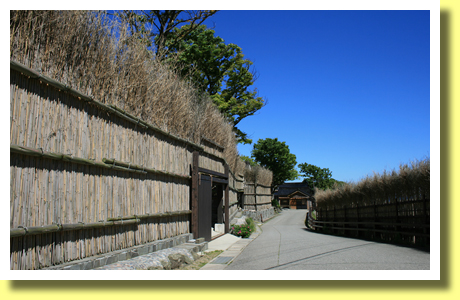
There are two villages called Ozawa and Kami Ozawa in the western suburbs of Wajima City. In the villages, houses are surrounded by Magaki ( above ) to protect from the seasonal strong wind in winter. Also Magaki make the moderate shade in summer. Magaki, unique to the villages, are fences made from thin Nigatake bamboos and as high as 4-5 meters.
|
|
Noto Fugu-don

In Wajima City, tourist could enjoy various seafood dishes such as Noto Fugu-don ( above ), which is a bowl of rice topped with pickled fugu ( pufferfish ), grated yam and spring onion. The city has commercial fishing ports whose catches of pufferfish is the largest in Japan.
|
|
Assorted Sushi
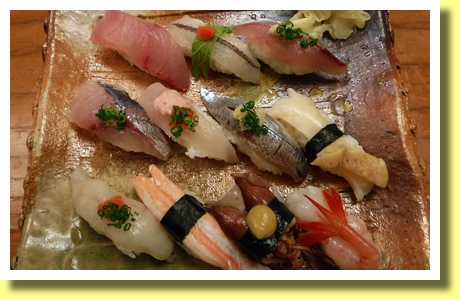
The catches of local commercial fishing ports include not only pufferfish but also various fishes. So in sushi restaurants in the city, assorted sushi ( above ) could be recommendable as well as assorted sashimi.
|
|
Agehama Style Salt Production

There had not been plenty of paddy fields in Noto Hanto ( peninsula ).
So terraced paddy fields had been developed such as Shiroyone Senmaida. On the other hand, salt production had evolved for some centuries. Along the coasts of Noto Hanto, there are some sites where tourists could see and experience traditional Agehama Style Salt Production ( above ).
|
|
Mitsuke-jima
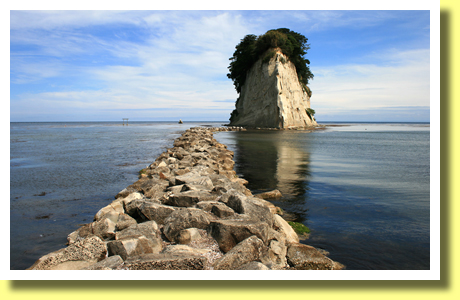
Off the east coast of Noto Hanto, there is a small rock island called Mitsuke-jima ( above ), located in Suzu City. Also it is called Gunkan-jima ( Battleship Island ) because of its resemblance.
|
|
Wakura Onsen
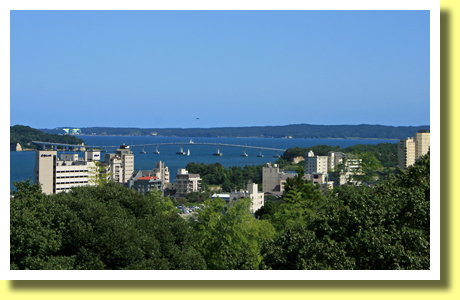
There is Wakura Onsen ( hot spring resort - above ) in Nanao City, located in the south of Noto Hanto. In Wakura Onsen are located dozens of large onsen ryokan - Japanese style big hotels and inns with in-house hot spring baths. Wakura Onsen, with history over 1,200 years, is popular and famous in Japan.
|
|
Ruins of Nanao-jo Castle

In Nanao City, there are ruins of Nanao-jo Castle ( above ), which was built in the early 16th century during Sengoku Jidai ( Age of Warring States ). Nanao-jo Castle was one of the largest medieval mountain castles in Japan. Its ruins are one of designated National Historic Sites of Japan. In the site, no building but large stone ramparts and dry moats remain.
|
|
Seafood in Nanao City
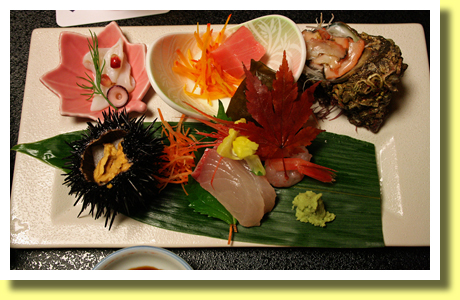
In Nanao City, tourists could enjoy various seafood dishes. There are many restaurants including sushi restaurants. Also Onsen Ryokan in Wakura Onsen would offer tourists various sefood dishes such as assorted sashimi ( above ).
|
Copyright (c) 2021 Achi-Kochi Zanmai Co., Ltd.
|